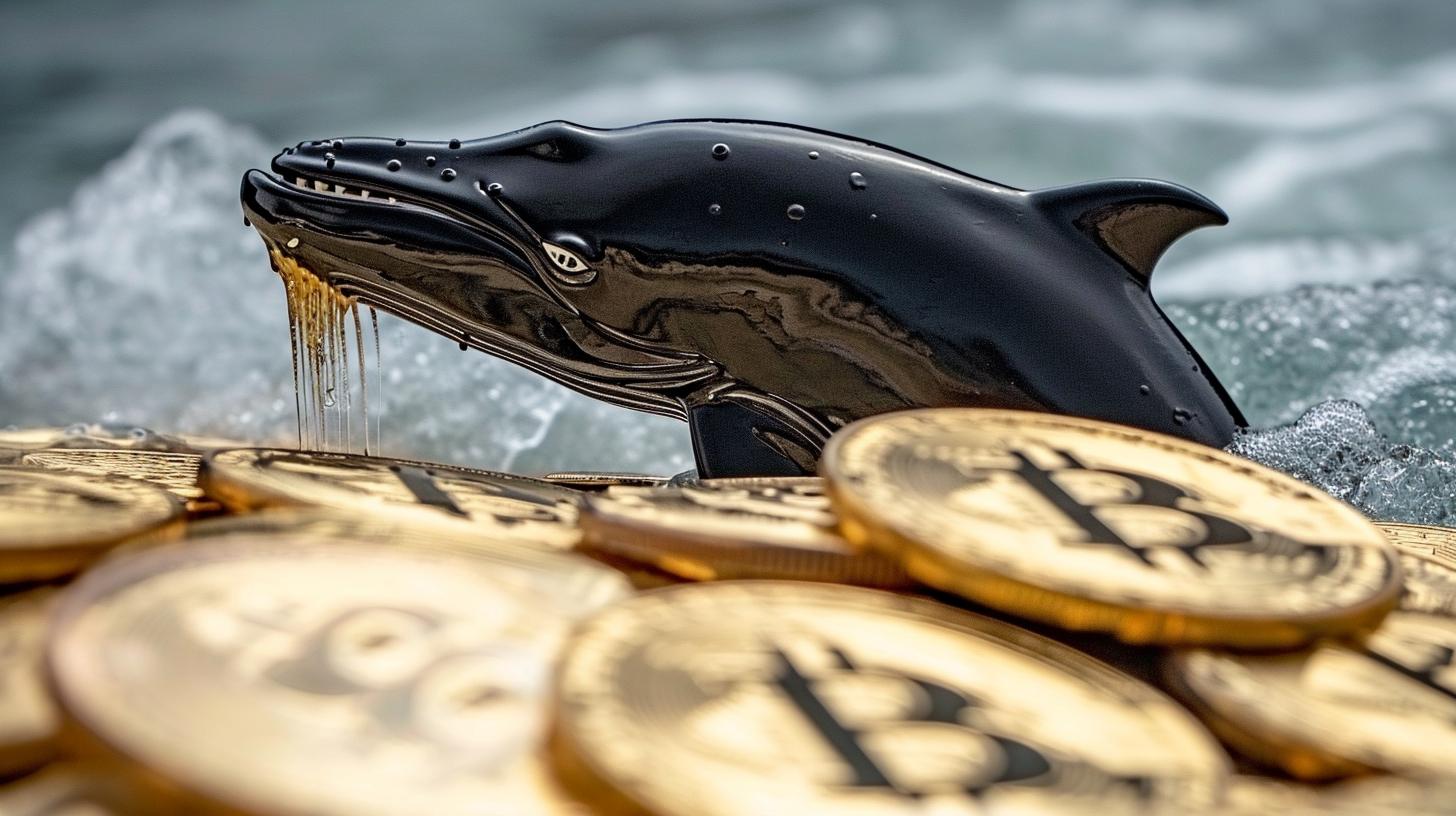
What is a whale in crypto? In the world of cryptocurrency, a “whale” refers to an individual or entity that holds a large amount of digital assets. These whales are known to possess significant influence over the market due to their ability to execute substantial buy or sell orders, causing ripples in cryptocurrency prices. Understanding the role of these whales in the crypto market is crucial for anyone involved in digital asset trading.
Crypto whales play a pivotal role in shaping the landscape of the cryptocurrency market. They have the power to single-handedly impact the prices of various digital assets, making their activities closely monitored by smaller investors and traders. This introductory section aims to delve into the characteristics, impact, and regulation of crypto whales, providing insights into how their actions can affect both individual traders and the entire market.
This article will explore various aspects related to crypto whales, including their defining characteristics, significant impact on cryptocurrency prices, methods for identifying whale activity, and even case studies showcasing notable whale moves in the cryptocurrency market. Additionally, we will also discuss potential risks and benefits associated with whale activity in crypto, as well as strategies for small investors to navigate their presence effectively.
By examining these key areas, readers will gain a comprehensive understanding of how whales operate within the cryptocurrency space and what it means for the future of this rapidly evolving market.
Understanding the Role of Whales in the Crypto Market
In the world of cryptocurrency, a “whale” refers to an individual or entity that holds a significant amount of a particular digital asset. These whales have the power to influence the market due to their ability to buy or sell large volumes of crypto at any given time. This section will delve into the importance of understanding the role of whales in the crypto market.
Whales play a crucial role in shaping the direction of cryptocurrency prices. Their large holdings allow them to manipulate the market by initiating significant buy or sell orders, causing price fluctuations that can impact both retail investors and smaller traders. This can create volatility and uncertainty in the market, making it essential for all participants to monitor whale activity.
Understanding how whales operate is vital for anyone involved in cryptocurrency trading or investing. By analyzing whale behavior and identifying trends, individuals can make more informed decisions about when to buy, sell, or hold their digital assets. Additionally, keeping an eye on whale activity can help traders anticipate potential market movements and adjust their strategies accordingly.
It is important for small investors and traders to be aware of what constitutes whale activity in order to navigate the volatile crypto market successfully. By staying informed about large transactions and monitoring trading volumes, individuals can mitigate risks associated with whale manipulation while also capitalizing on potential opportunities created by these influential market players.
Overall, grasping the role of whales in the crypto market is essential for anyone looking to participate in this space successfully. By understanding how these influential entities can impact prices and market sentiment, individuals can make more educated decisions when it comes to buying, selling, or holding digital assets. Furthermore, being aware of the strategies employed by whales can help smaller investors navigate and thrive in this dynamic and often unpredictable environment.
Characteristics of Crypto Whales
Crypto whales are a significant part of the cryptocurrency market, playing a major role in influencing prices and market trends. But what is a whale in crypto? In simple terms, a whale refers to an individual or entity that holds a substantial amount of cryptocurrency. These entities have the power to significantly impact the market due to their large holdings and trading activities.
One of the main characteristics of crypto whales is their substantial holdings of digital assets. These can range from millions to billions of dollars worth of cryptocurrency, giving them significant influence over market movements. Additionally, whales are often able to move the markets simply by buying or selling large quantities of cryptocurrency at once, causing ripples that smaller traders may not be able to influence.
Another characteristic of crypto whales is their ability to manipulate prices. Due to their substantial holdings, they can engage in tactics such as pump and dump schemes, where they artificially inflate the price of a cryptocurrency through coordinated buying before selling off at a profit. This can lead to significant volatility in the market and affect smaller investors who may not have the same resources at their disposal.
Furthermore, crypto whales often prefer to operate away from the public eye through over-the-counter (OTC) trades or private deals. This allows them to make significant moves without causing immediate price fluctuations on exchanges. It also makes it more challenging for regular investors to anticipate market movements based on whale activity.
| Characteristics | Crypto Whales |
|---|---|
| Holdings | Millions to billions of dollars worth of cryptocurrency |
| Market Influence | Ability to manipulate prices and create market volatility |
| Operating Preference | Prefer OTC trades and private deals for discretion |
Impact of Whales on Cryptocurrency Prices
Market Manipulation
Whales in the crypto market have a significant impact on cryptocurrency prices, often being accused of market manipulation. Due to their large holdings, whales have the power to influence the market by buying or selling large volumes of crypto assets.
By strategically executing trades, whales can create artificial demand or supply, leading to price movements that smaller investors may not be able to predict or control. This ability to manipulate the market is seen as a major concern for regulators and small investors alike.
Volatility
The actions of whales can result in extreme volatility in the cryptocurrency market. Large sell-offs by whales can lead to sudden and significant drops in prices, causing panic among smaller investors and triggering a domino effect.
On the other hand, strategic buying by whales can drive up prices quickly, creating FOMO (fear of missing out) and speculative trading behavior among retail investors. This volatility poses risks for all participants in the market and can make it difficult for small investors to make informed decisions about their investments.
Long-Term Implications
The influence of whales on cryptocurrency prices also has long-term implications for the market as a whole. If whale activity continues unchecked, it could lead to a lack of stability and confidence in cryptocurrencies as viable investment options.
Additionally, if whale manipulation causes significant losses for small investors, it could erode trust in the legitimacy and fairness of the crypto market. Therefore, understanding and mitigating the impact of whales on cryptocurrency prices is crucial for maintaining a healthy and sustainable crypto ecosystem.
Identifying Whale Activity in the Crypto Market
Whales in the crypto market are known for their large investment and trading activities that can significantly impact the price of cryptocurrencies. But how can one identify whale activity in the market? One way is to look at the volume of transactions. Whales typically make large buy or sell orders that can cause sudden spikes or drops in the price of a cryptocurrency. Monitoring transaction volumes and identifying unusually large trades can help investors spot whale activity.
Another indicator of whale activity is wallet addresses. Whales often have large wallets with substantial holdings of cryptocurrencies. By monitoring wallet addresses with significant balances, investors can track the movement of funds and identify potential whale activity. Additionally, analyzing order book data on exchanges can reveal large buy or sell orders that may be indicative of whale activity.

Social media and online forums can also be sources of information on whale activity. Cryptocurrency communities often discuss large transactions or movements by notable individuals or entities in the market. Keeping an eye on these discussions can provide valuable insights into whale behavior and potential market impacts.
| Indicator | Description |
|---|---|
| Transaction Volumes | Tracking unusually large trades to spot whale activity |
| Wallet Addresses | Analyzing addresses with significant balances to monitor movement of funds |
| Order Book Data | Examining exchange data for large buy or sell orders that may indicate whale activity |
Risks and Benefits of Whales in Crypto
Crypto whales, also known as large holders of cryptocurrency, play a significant role in the crypto market. Their massive holdings and trading activities can greatly impact the prices of cryptocurrencies, leading to both risks and benefits for other market participants.
Here are some of the key risks and benefits associated with whales in the crypto market:
Risks:
- Price Manipulation: Whales have the capability to manipulate cryptocurrency prices through large buy or sell orders, leading to volatility and uncertainty for smaller investors.
- Market Influence: The decisions made by whales can influence the direction of the entire market, causing rapid price swings and potential losses for others.
- Lack of Regulatory Oversight: The unregulated nature of the crypto market allows whales to operate without clear guidelines, posing risks for unsuspecting investors.
Benefits:
- Liquidity Provision: Whales often provide liquidity to the market through their large trades, which can benefit smaller traders by enabling easier buying and selling of cryptocurrencies.
- Market Signals: The actions of whales can serve as signals for other investors, indicating potential trends or opportunities in the crypto market.
- Supporting Projects: Some whales actively support promising projects in the crypto space by investing substantial amounts of capital, contributing to innovation and development within the industry.
It is important for all participants in the crypto market to be aware of the risks and benefits associated with whale activity. Understanding these dynamics can help small investors navigate the market more effectively and make informed decisions regarding their crypto holdings.
Regulating Whale Activity in the Crypto Market
Challenges of Regulating Whales
Regulating whale activity in the crypto market presents several challenges. One major challenge is the decentralized nature of cryptocurrencies, which makes it difficult to implement strict regulations. Additionally, whales often have the resources to operate across multiple jurisdictions, making it challenging for regulatory bodies to enforce rules and sanctions.
Another challenge is the anonymity associated with cryptocurrency transactions. Whales can execute large trades without disclosing their identities, making it harder for regulators to track their activities. This lack of transparency poses a significant obstacle when trying to regulate whale activity in the crypto market.
Potential Regulatory Measures
Despite these challenges, there are potential regulatory measures that could be implemented to mitigate the impact of whales on the cryptocurrency market. One approach is to introduce position limits for large traders, setting a cap on the amount of cryptocurrency that a single entity or individual can hold or trade within a specific time frame. This would serve to prevent whales from exerting too much influence on prices through their trading activities.

In addition, enhanced disclosure requirements could be imposed on large holders of cryptocurrencies. Requiring whales to publicly disclose their holdings and trading activities would improve transparency in the market, allowing other investors and regulatory bodies to monitor whale behavior more effectively.
The Role of Self-Regulation
Furthermore, self-regulation within the cryptocurrency community can also play a vital role in addressing whale activity. By establishing best practices and guidelines for trading and market behavior, industry participants can collectively work towards creating a more fair and transparent crypto market. Collaborative efforts between exchanges, industry associations, and market participants could lead to voluntary standards that help mitigate the negative impact of whales on cryptocurrency prices.
Overall, while regulating whale activity in the crypto market presents significant challenges, there are various potential measures that could be explored by regulatory bodies and industry participants to address this issue effectively.
Cryptocurrency markets are known for their volatility, partly due to the influence of large holders known as “whales.” These whales are individuals or entities that hold a significant amount of a particular cryptocurrency, giving them the power to move markets with their trades. For small investors, navigating whale activity in the crypto market can be challenging but not impossible. Here are some strategies to consider:
- Diversify Your Portfolio: One way to mitigate the impact of whale activity is to diversify your crypto holdings. By spreading your investments across different cryptocurrencies, you reduce the risk of being heavily affected by the actions of a single whale in any particular market.
- Stay Informed: Keeping abreast of market news and developments is crucial for small investors looking to navigate whale activity. Understanding the factors influencing whale behavior and being aware of any significant moves can help you make informed decisions about your investments.
- Use Stop-Loss Orders: Implementing stop-loss orders on your trades can help protect your investments from sudden price swings caused by whale activity. This strategy allows you to set a predetermined price at which you would sell your assets, thereby limiting potential losses.
It’s also essential for small investors to understand that while whales can have a substantial impact on cryptocurrency prices, they are not infallible. By employing these strategies and staying attuned to market dynamics, small investors can navigate whale activity in the crypto market more effectively and make informed decisions regarding their investments.
With these strategies in mind, small investors can approach the crypto market with greater confidence and resilience against potential disruptions caused by whale activity. By remaining proactive and adaptable in their investment approach, they can work towards achieving their financial goals amidst the presence of whales in the cryptocurrency space.
Case Studies
One notable example of a whale move in the cryptocurrency market is the case of the infamous “Bitcoin Whales” who are known for holding large amounts of Bitcoin. These whales have been known to make significant transactions that have had a noticeable impact on the price of Bitcoin.
For instance, in 2017, a single Bitcoin whale was responsible for triggering a sharp drop in the price of Bitcoin by selling off a large amount of their holdings. This move caused panic selling among smaller investors and contributed to a downturn in the market.
Another notable case study is the “Ethereum Whale” that made headlines in 2016 when it moved over $55 million worth of Ethereum in just one transaction. This massive movement of funds caused a stir in the cryptocurrency community and led to speculation about the motives behind such a large transaction. The Ethereum whale’s actions sparked discussions about the influence that large holders can have on the market and raised questions about potential market manipulation.
One more recent example is the case of Dogecoin, where a single wallet holding billions of dollars’ worth of Dogecoin has been closely watched by investors and analysts alike. The movements and transactions of this Dogecoin whale have been scrutinized for any signs of potential market manipulation or other malicious activity.
These case studies serve as important examples of how whale activity can significantly impact cryptocurrency prices and investor sentiment, highlighting the need for greater transparency and regulation within the crypto market.
Conclusion
In conclusion, the concept of crypto whales, as we have discussed throughout this article, holds considerable significance in the cryptocurrency market. These influential players possess the power to impact prices and market trends, making them a subject of interest and concern for many. As the crypto market continues to evolve and grow, it is evident that understanding whale behavior and their potential impact is crucial for both individual investors and regulatory bodies.
Looking ahead, the future of whales in crypto remains uncertain. The influence of these large holders on the market will largely depend on how their activities are regulated and monitored. As the industry matures, there may be increased efforts to address potential risks associated with whale activity, while still allowing for organic market movements.
For small investors navigating the crypto market, it will be important to stay informed about whale activity and develop strategies to mitigate potential risks associated with sudden price movements caused by such entities. Additionally, maintaining a long-term perspective and staying attuned to fundamental factors driving cryptocurrency adoption can help reduce vulnerability to short-term volatility driven by whale activity.
Ultimately, as the cryptocurrency market continues to mature, all participants must adapt to these dynamics while keeping an eye on how whale behavior may evolve in the future.






